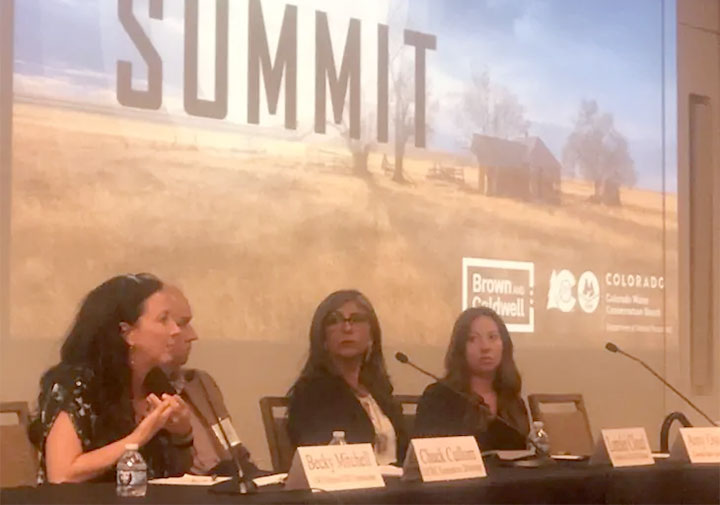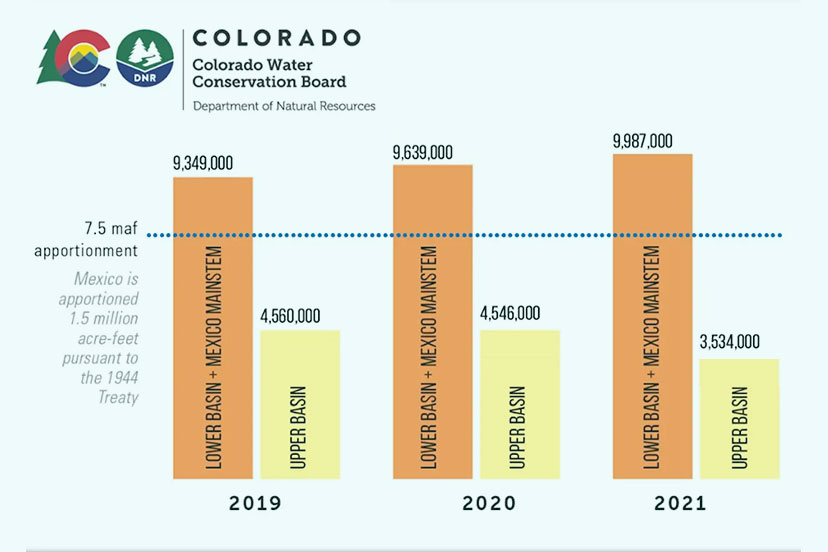This op-ed appeared on Big Pivots on June 8, 2023. We are sharing it in two parts.
Chuck Cullom was speaking before a friendly audience on June 1 when he shared his perspective on the messy story in the Colorado River Basin.
“Is the press here?” he asked early in his remarks, surely knowing that the event, the Colorado Drought Summit, was being taped for later posting on the website of the Colorado Water Conservation Board, the sponsor of the two-day meeting. “Is anybody here from a ski town?”
Since 2021, Cullom has directed the Upper Colorado River Commission, which represents Colorado and three other upper-basin states of Utah, Wyoming, and New Mexico. This is distinct from the lower basin, which consists of Arizona, California and Nevada.
The bifurcation, primarily a legal one but a hydrologic one, too, was created by the Colorado River Compact in 1922. The division is marked by Lee Ferry, just below what is now Glen Canyon Dam and the launch point for boaters rafting the Grand Canyon. Most of the water in the Colorado River Basin comes from upstream, especially from snow, and especially in Colorado.
For the 25 years prior to his current position, Cullom was in the lower basin, most immediately before at the Central Arizona Project. That giant straw, the last major one stuck into the Colorado River, delivers water to Phoenix, Tucson, and other cities as well as some agriculture users in Arizona. It’s also worth noting that there has always been friction between Arizona and California.
Now, from his base in the greater Salt Lake City area, he’s just across the hill from Park City, one of the top mountain resorts.
“So we have what are referred to as the trustafarians, which is a tribe of people who live off their trust funds,” he said. “Trustafarians tend to drive something between a new Subaru and a Range Rover, but with the latest kit bolted atop. I don’t know if they ever take it off, but they do have skis and mountains bikes and stuff—and they expect their paycheck every month from daddy or whomever. And they are insufferable.”
“You better be going someplace with this,” quipped another panelist, Becky Mitchell, the director of the Colorado Water Conservation Board, known in water circles by CWCB. She is also Colorado’s voice on Colorado River affairs.
Mitchell had just wrapped up a critique of the recently announced agreement in which the federal government is to give lower-basin states $1.2 billion to curtail about 10% of their withdrawals from the Colorado River during the next three years. During that time, at least in theory, the basin states will have figured out how to solve their bad-math problem. During the 21st century, they’ve been withdrawing more water than the river has delivered. The two basins — upper and lower — do not share equal responsibility. The lower-basin has been drafting on the water banked during wetter times.
Like ski town trustafarians, Cullom explained, the lower-basin has a sense of entitlement. Trustafarians don’t have to get a job when the money runs out, and the lower-basin states for most of the last century have never had to live within the limitations of natural runoff.
Upstream of the desert empires lies Hoover Dam and, above that, Glen Canyon Dam — plus a lot of other much smaller dams and reservoirs, about 50 million acre-feet in total capacity, which provide assurances that the water will be available, no matter what is happening in the headwaters.
But what has been happening most years in the 21st century has been drought and its longer-term and less reversible component, ‘aridification’.

Mitchell, who was first in the batting order in the program, has never been one to mince words. She seemed particularly animated as she described being in Phoenix the previous day to present the upper-basin’s perspective. The majority of the day was devoted to sharing “their concerns over security and certainty that they felt they were entitled to,” she said.
One can wonder how her message may have been delivered on the road as opposed to a home-court crowd.
“When we talk about security and certainty, the way that water is being used in the lower basin is damaging all of our security and certainty, not just their own.”
As did Cullom, Mitchell described a system that has shielded the lower-basin states from the hydrologic realities.
Colorado and other upper-basin states must largely live within the natural water budget, what falls from the sky. There are many dams and reservoirs, but even the largest are almost tiny in their capacities compared to the behemoths of Powell and Mead. Having those giant reservoirs above them allows California and Arizona to be certain that the water will be there for their cities and crops, be it lettuce in winter, or alfalfa and almond groves in summer. Agriculture, particularly in the Imperial Valley of California and the Yuma area of Arizona, has the most secure water systems.
In a sense, Mead and Powell represent savings accounts. Now, as all of the nation understands, the result of new and devoted national media interest, those bank accounts have verged on functional depletion. Going into this winter, the two reservoirs were 26% and 23% full.
There was legitimate worry that, given just another dry winter, hydroelectric production at Glen Canyon would cease and, with another dry winter or two, Powell might drop to levels such that it could not allow water to go downstream, a level called dead pool.
The marvel in all this is that California, especially, and to a lesser extent Arizona, have not fundamentally changed anything in the last 20 years. According to Cullom, the lower basin states have been consuming about 10 million acre-feet. This compares to about 3.5 to 3.75 million acre-feet by the upper-basin states.
The Colorado River Compact stipulates equal apportionment between the two basins of 7.5 million acre-feet for each basin, on a rolling 10-year average.
Almost everybody has heard talk about whether the Colorado River Compact needs to be renegotiated, said Mitchell. It does not, she declared. Instead, it needs to be honored.
“The foundational principle of that compact is equity. Sit with that for a little bit,” she said.
“While these quantities are distracting and we know that the river is supplying less than it did a 100 years ago, that doesn’t take away from the foundation principles of this compact. With that being said, I believe that the compact is flexible enough to adapt to these conditions. We, as humans, are flexible enough to include other voices in these conversations,” added Mitchell, a reference to Lorelei Cloud, a representative of the Southern Utes who was also on the Colorado River panel at the conference.
Native Americas, if almost completely ignored when the waters of the Colorado River were being apportioned, in fact have the most senior of rights as determined by the U.S. Supreme Court in a 1908 case that yielded the Winters Doctrine. Those rights in the Colorado River Basin are estimated to be 20% to 25% of the river’s total flows. Tribes in Colorado and other upper-basin states have had their allocations determined, but the work remains incomplete in the lower basin.
Mitchell and Cullom also described efforts by upper basin states, if not always successful, to begin pruning water use in anticipation of possibly hotter, drier times ahead. Lower basin states have made some adjustments, but the question is whether they are remotely close to what is needed.
“When we saw the flags of a crisis coming, there was a choice by some to not make changes that are going to be painful,” said Mitchell, alluding to the lower basin.
Upper-basin states, she went on to explain, did make choices. In her description, users in upper-basin states did suffer, pointing to the divergent numbers of the upper-basin and the lower basin. in a chart on the screen behind her. (See above).
“These numbers tell the story of how change has to happen. And so when people get tired of us sharing the numbers, we’re going to share them some more.”
Cullom made a similar point. “It’s a threshold difference when you live downstream of 50-plus million acre-feet of storage. Your concerns about your year-over-year precipitation and runoff in operations are pretty marginal. It’s very, very different up here. Last summer, fully one-third of Wyoming’s users on the Green River (a tributary to the Colorado) were shut off, regulated off.”
That, he added, is not something understood in the lower basin. “It means you are out of priority.”
It means that you are out of priority that day, that week, that month. And the state engineer, who in Wyoming is a law-enforcement official, comes and shuts you off. That is not a thing in the lower basin. But in August and September (of 2022, fully one-third of growers in the Green were curtailed. Ninety percent of the Ute Mountain Ute water was curtailed, their agricultural productivity was reduced because of hydrology.”
There’s another difference, he went on to say: the upper basin has tens of thousands of individual water users and “turnouts,” places where water is diverted. In the lower basin, there are probably 30 main-stem turnouts… of which fewer than 10 really matter.
The upper basin, he said, is “small, messy and complicated. The lower basin is just a corporate machine of giant turnouts…”
Allen Best publishes the e-journal Big Pivots, which chronicles the energy transition in Colorado and beyond.


